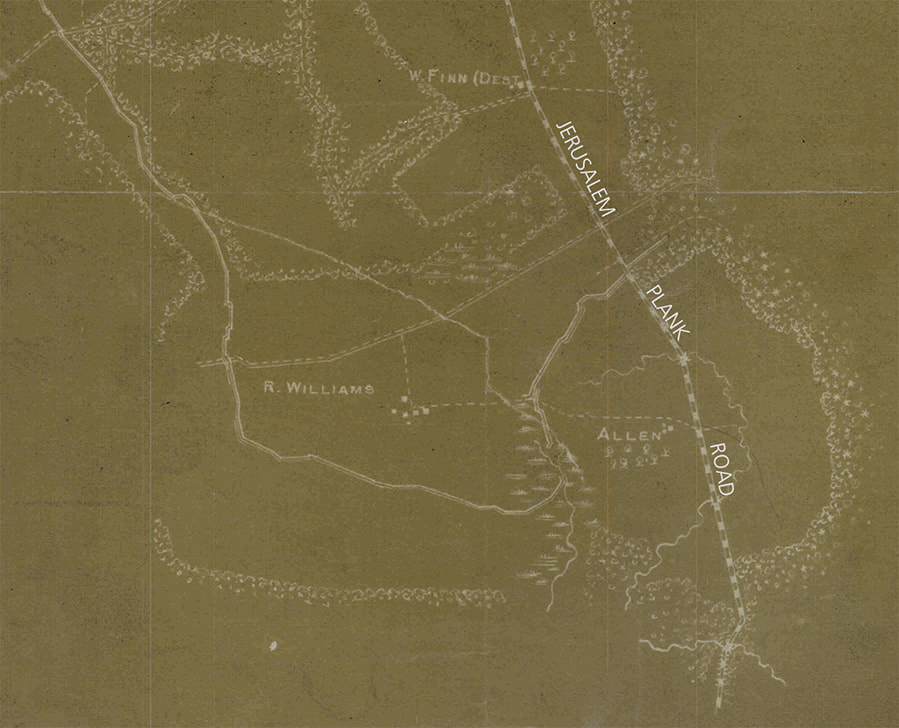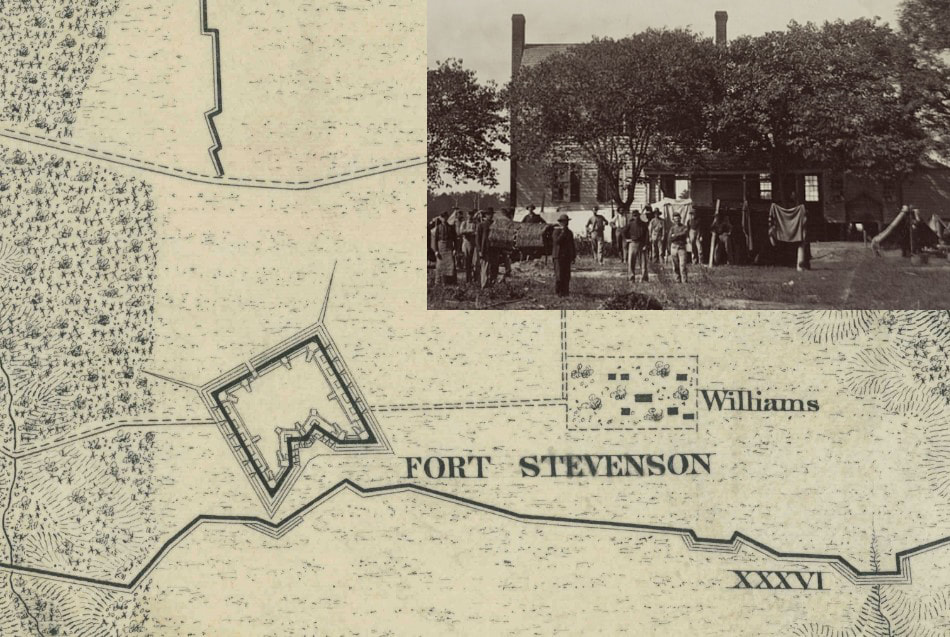Richard Williams House
The R. Williams house west of the Jerusalem Plank Road was a major landmark in the movement of troops during summer and fall of 1864. The house was a pivotal location during the fighting of June 21-24, when it served for a time as Second Corps headquarters. The house was at the center of a Fifth Corps hospital in July. The grounds served as camp for the U. S. Engineers in September. The house is depicted in at least one photograph and a drawing. Fort Stevenson, one of the major forts on the line of circumvallation, was build near the house.
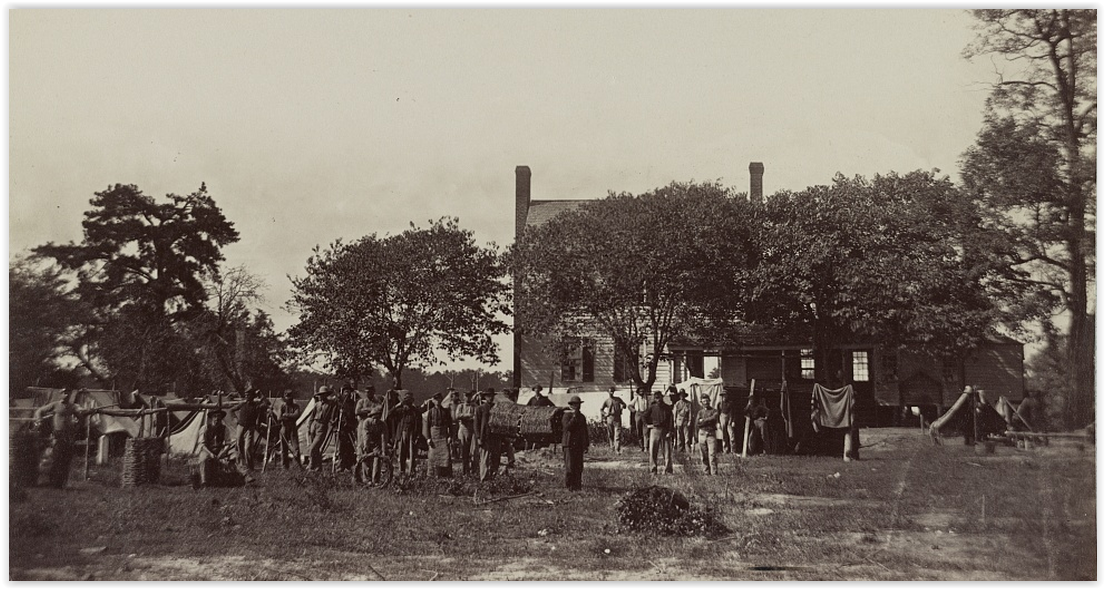
Cropped version of LC 32998. Headquarters U.S. Engineer Battalion in front of Petersburg, Va., September, 1864. Although this structure is not identified as the Williams house on the negative, Thompson's diary states the U.S. Engineers were quartered there in September 1864. The chimneys, roof style and trees match the McCallum drawing below.
Field Hospital in late August 1864
Excerpted from Itineraries of the Army of the Potomac O.R. vol. 40, part 1, 179-194.
SECOND ARMY CORPS
June 21. Moved to the left, crossing Jerusalem plank road to Williams house; took position on the left; First Division skirmishing with the enemy and capturing prisoners. July 12. Destroyed the corps line of intrenchments and massed at Williams house. July 13. Moved to vicinity of Deserted House, going in reserve.
1ST DIVISION, 2ND CORPS
June 21. Marched to the left, near Williams house; advanced to within one mile and a quarter of Weldon railroad, but were recalled. June 22. Advanced, but were obliged to return to first position to prevent being outflanked. July 2. Moved to Williams house, destroying the intrenchments previously held by the division. At 6 p. m. of the same day moved to the junction of the Jerusalem plank and Reams Station roads, returning to Williams house at 11 p. m.
4TH BRIGADE, 1ST DIVISION, 2ND CORPS
July 12. The command moved from its old position toward the Williams house, where it laid in line until dark, when it took up a line of march south on the Jerusalem plank road to support Greggs division of cavalry, returning at midnight to the Williams house.
3RD DIVISION, 2ND CORPS
July 12. Division, except the picket-line, withdrawn from the intrenchments at about 3 a. m. by way of the Jones house and plank road, massing about one mile to the left and rear, near the Williams house.
3RD BRIGADE, 3RD DIVISION
July 12. Moved to the left one mile and massed on the Jerusalem plank road near the Williams house. July 13. Moved to the right about two miles rear of the Dunn house.
FIFTH ARMY CORPS
2ND BRIGADE, 2ND DIVISION, 5TH CORPS
June 23. At 5 p. m. the brigade was ordered to report to General Wright, commanding Sixth Army COrps, at Williams house; were placed in line on the extreme left of the army, protecting the flank; threw up earth-works. At 12 o’clock, midnight, the brigade was ordered to take position on the left of Williams house, where it remained until 5 p. m. of the 24th, when it rejoined division.
3RD DIVISION, 5TH CORPS
July 14. Relieved all of the Second Corps picket-line from the Jerusalem plank road near Williams house, on the left, to the point of woods where the line breaks to the rear on the right by Third Brigade.
SIXTH ARMY CORPS
3RD DIVISION, 6TH ARMY CORPS
June 21. Marched at 4.40 p. m.; crossed the Petersburg and Weldon [Norfolk and Petersburg ?] Railroad; went into position west of the plank road, near Williams house. June 22.Threw up works; some skirmishing about dark; advanced the lines about one mile. June 23 to 28. Remained at same place. June 30. Threw up works and destroyed railroad. At 4.30 p. in. marched back to where we last left the plank road near Williams house.
SECOND ARMY CORPS
June 21. Moved to the left, crossing Jerusalem plank road to Williams house; took position on the left; First Division skirmishing with the enemy and capturing prisoners. July 12. Destroyed the corps line of intrenchments and massed at Williams house. July 13. Moved to vicinity of Deserted House, going in reserve.
1ST DIVISION, 2ND CORPS
June 21. Marched to the left, near Williams house; advanced to within one mile and a quarter of Weldon railroad, but were recalled. June 22. Advanced, but were obliged to return to first position to prevent being outflanked. July 2. Moved to Williams house, destroying the intrenchments previously held by the division. At 6 p. m. of the same day moved to the junction of the Jerusalem plank and Reams Station roads, returning to Williams house at 11 p. m.
4TH BRIGADE, 1ST DIVISION, 2ND CORPS
July 12. The command moved from its old position toward the Williams house, where it laid in line until dark, when it took up a line of march south on the Jerusalem plank road to support Greggs division of cavalry, returning at midnight to the Williams house.
3RD DIVISION, 2ND CORPS
July 12. Division, except the picket-line, withdrawn from the intrenchments at about 3 a. m. by way of the Jones house and plank road, massing about one mile to the left and rear, near the Williams house.
3RD BRIGADE, 3RD DIVISION
July 12. Moved to the left one mile and massed on the Jerusalem plank road near the Williams house. July 13. Moved to the right about two miles rear of the Dunn house.
FIFTH ARMY CORPS
2ND BRIGADE, 2ND DIVISION, 5TH CORPS
June 23. At 5 p. m. the brigade was ordered to report to General Wright, commanding Sixth Army COrps, at Williams house; were placed in line on the extreme left of the army, protecting the flank; threw up earth-works. At 12 o’clock, midnight, the brigade was ordered to take position on the left of Williams house, where it remained until 5 p. m. of the 24th, when it rejoined division.
3RD DIVISION, 5TH CORPS
July 14. Relieved all of the Second Corps picket-line from the Jerusalem plank road near Williams house, on the left, to the point of woods where the line breaks to the rear on the right by Third Brigade.
SIXTH ARMY CORPS
3RD DIVISION, 6TH ARMY CORPS
June 21. Marched at 4.40 p. m.; crossed the Petersburg and Weldon [Norfolk and Petersburg ?] Railroad; went into position west of the plank road, near Williams house. June 22.Threw up works; some skirmishing about dark; advanced the lines about one mile. June 23 to 28. Remained at same place. June 30. Threw up works and destroyed railroad. At 4.30 p. in. marched back to where we last left the plank road near Williams house.

No. 12. Report of Maj. Nathaniel Michler, Corps of Engineers, U. S. Army. HDQRS. ARMY OF THE POTOMAC, ENGINEER DEPARTMENT, GENERAL: October 20, 1864. O.R. vol. 40, part 1, 290
The Second and Sixth Corps were the active participants in the several severe fights which took place in the endeavors to reach the Weldon railroad. The several officers of engineers accompanied these movements. An intrenched line was finally taken up and held, running nearly south from the Appomattox along the front of Petersburg to the Jerusalem plank road, and then almost parallel to that road, with the left refused and again crossing it near the Williams house. The headquarters of the major-general commanding were moved on the 23d to the neighborhood of the Jones house, and remained encamped there for nearly three weeks.
The Second and Sixth Corps were the active participants in the several severe fights which took place in the endeavors to reach the Weldon railroad. The several officers of engineers accompanied these movements. An intrenched line was finally taken up and held, running nearly south from the Appomattox along the front of Petersburg to the Jerusalem plank road, and then almost parallel to that road, with the left refused and again crossing it near the Williams house. The headquarters of the major-general commanding were moved on the 23d to the neighborhood of the Jones house, and remained encamped there for nearly three weeks.
Excerpted from Daily Memoranda of Second Army Corps. O.R. vol. 40, part 1, 318-320
June 21, 1864.Corps moved to-day toward Norfolk and Petersburg Railroad, crossing that railroad near Deserted House, and striking Jerusalem plank road near Williams house, then took position on left of Fifth Corps, about two miles from Weldon railroad. Corps head-quarters established just in front of Jones house, near Jerusalem plank road. General Birney in command of corps. ... June 29, 1864.Sixth Corps moved from left of Second toward Reams Station, on Norfolk and Petersburg Railroad. General Gibbon occupied intrenchments vacated by Sixth Corps toward the Williams house. Lieutenant-Colonel Jones reported to General Hancock from army headquarters with detachment of cavalry 1,000 strong; took position in intrenchments between Williams house and Jerusalem plank road. June 30, 1864.Sixth Corps at Reams Station; General Ferrero reported to General Hancock with division of colored troops (Ninth Corps), and took position in intrenchments from General Gibbons left near Williams house, to Jerusalem plank road. ... July 9, 1864. First and Second Divisions, Sixth Corps, moved from our left toward City Point. Second Corps occupied the line vacated by them, our line extending on the left nearly to Williams house. Mott's brigade, Third Division, on left of General Gibbon, Second Division. General Ferrero's division (colored troops) taking position on left of Mott's brigade, extending over Jerusalem plank road. July 10, 1864. No important movements this day by the Second Corps. Firing going on as usual along our line. July 11, 1864. Orders received to move out of our rifle-pits to-night, to destroy the works in vicinity of Williams house, and to mass corps in vicinity of said house. July 12, 1864.Corps moved out at 3 o'clock this a.m. and massed in neighborhood of Williams house. Destroyed works in compliance with orders.
June 21, 1864.Corps moved to-day toward Norfolk and Petersburg Railroad, crossing that railroad near Deserted House, and striking Jerusalem plank road near Williams house, then took position on left of Fifth Corps, about two miles from Weldon railroad. Corps head-quarters established just in front of Jones house, near Jerusalem plank road. General Birney in command of corps. ... June 29, 1864.Sixth Corps moved from left of Second toward Reams Station, on Norfolk and Petersburg Railroad. General Gibbon occupied intrenchments vacated by Sixth Corps toward the Williams house. Lieutenant-Colonel Jones reported to General Hancock from army headquarters with detachment of cavalry 1,000 strong; took position in intrenchments between Williams house and Jerusalem plank road. June 30, 1864.Sixth Corps at Reams Station; General Ferrero reported to General Hancock with division of colored troops (Ninth Corps), and took position in intrenchments from General Gibbons left near Williams house, to Jerusalem plank road. ... July 9, 1864. First and Second Divisions, Sixth Corps, moved from our left toward City Point. Second Corps occupied the line vacated by them, our line extending on the left nearly to Williams house. Mott's brigade, Third Division, on left of General Gibbon, Second Division. General Ferrero's division (colored troops) taking position on left of Mott's brigade, extending over Jerusalem plank road. July 10, 1864. No important movements this day by the Second Corps. Firing going on as usual along our line. July 11, 1864. Orders received to move out of our rifle-pits to-night, to destroy the works in vicinity of Williams house, and to mass corps in vicinity of said house. July 12, 1864.Corps moved out at 3 o'clock this a.m. and massed in neighborhood of Williams house. Destroyed works in compliance with orders.
O.R. vol. 40, part 1, 275
HDQR'S SECOND CORPS, R. Williams, west of and near to plank road, June 21, 1864
12.55 p. m. (Sent 5.35 p.m.)
Major-General MEADE:
Just arrived. General Birney here. As I entered woods, say one mile from General Warrens, struck General Mott's, the rear division, moving rapidly and well closed. The country with little water, wooded rather closely with pine and oak; no hills. About four open fields before getting to this road, three on right, one on left of the route. At this point there are large open fields with irregular undulations. Orderly now sent to get out the telegraph, which will take some time. I should guess it was four or five miles by this rear route to General Warren's. Barlow has gone on cautiously with cavalry to make a reconnaissance to the Weldon road. Two divisions are massing here, preparatory to advancing and taking position on the left of General Griffin. THEODORE LYMAN.
HDQR'S SECOND CORPS, Dick Williams House, June 21, 1864
1.45 p.m. (Sent 5.30 p.m.)
General WILLIAMS, Assistant Adjutant- General: General Barlow reports at 1.10 that he is two miles and a half from the railroad, pushing forward. The cavalry he has with him have had some firing, but Barlow thinks there is no force.
D. B. BIRNEY, Major- General.
WILLIAMS House, June 21, 18645.10 p. m.
Major-General MEADE: I have just been to meet General Barlow. About a mile from the railroad he engaged dismounted cavalry and two guns. He took the colonel of the Third North Carolina Cavalry, who thinks that Early is behind on the railroad. He withdrew as ordered. He is now cutting a road to go into position next Mott, Gibbon being On the right, next Griffin. He has directed Captain Crowninshield to picket his left. Prisoners just in from First, Second, and Third North Carolina Cavalry. THEODORE LYMAN.
HDQR'S SECOND ARMY CORPS, June 21, 1864 10.30 p. m.
General WILLIAMS, Assistant Adjutant-General: GENERAL: I have the honor to report that this corps is in position to the left of the Jerusalem road. The withdrawal of Barlow's division from the reconnaissance toward the Weldon railroad brought on an attack of the enemy on my left flank toward dark. The cavalry was driven back, but my infantry soon checked the advance. It was reported to me as consisting of cavalry and infantry. The enemy approached on the road by the Williams house and nearly to the rear of the house. I requested General Ricketts to move out the road toward the Weldon railroad, on which Barlow moved in the morning, and his division is now on my left covering that road.
12.55 p. m. (Sent 5.35 p.m.)
Major-General MEADE:
Just arrived. General Birney here. As I entered woods, say one mile from General Warrens, struck General Mott's, the rear division, moving rapidly and well closed. The country with little water, wooded rather closely with pine and oak; no hills. About four open fields before getting to this road, three on right, one on left of the route. At this point there are large open fields with irregular undulations. Orderly now sent to get out the telegraph, which will take some time. I should guess it was four or five miles by this rear route to General Warren's. Barlow has gone on cautiously with cavalry to make a reconnaissance to the Weldon road. Two divisions are massing here, preparatory to advancing and taking position on the left of General Griffin. THEODORE LYMAN.
HDQR'S SECOND CORPS, Dick Williams House, June 21, 1864
1.45 p.m. (Sent 5.30 p.m.)
General WILLIAMS, Assistant Adjutant- General: General Barlow reports at 1.10 that he is two miles and a half from the railroad, pushing forward. The cavalry he has with him have had some firing, but Barlow thinks there is no force.
D. B. BIRNEY, Major- General.
WILLIAMS House, June 21, 18645.10 p. m.
Major-General MEADE: I have just been to meet General Barlow. About a mile from the railroad he engaged dismounted cavalry and two guns. He took the colonel of the Third North Carolina Cavalry, who thinks that Early is behind on the railroad. He withdrew as ordered. He is now cutting a road to go into position next Mott, Gibbon being On the right, next Griffin. He has directed Captain Crowninshield to picket his left. Prisoners just in from First, Second, and Third North Carolina Cavalry. THEODORE LYMAN.
HDQR'S SECOND ARMY CORPS, June 21, 1864 10.30 p. m.
General WILLIAMS, Assistant Adjutant-General: GENERAL: I have the honor to report that this corps is in position to the left of the Jerusalem road. The withdrawal of Barlow's division from the reconnaissance toward the Weldon railroad brought on an attack of the enemy on my left flank toward dark. The cavalry was driven back, but my infantry soon checked the advance. It was reported to me as consisting of cavalry and infantry. The enemy approached on the road by the Williams house and nearly to the rear of the house. I requested General Ricketts to move out the road toward the Weldon railroad, on which Barlow moved in the morning, and his division is now on my left covering that road.
O.R. vol. 40, part 1, 343, 347, 349
HEADQUARTERS ARMY OF THE POTOMAC, June 23, 1864 3.50 p.m.
Major-General WARREN, Commanding Fifth Corps: General Wright reports at 3.15 p.m. that the enemy have moved infantry down the Weldon railroad that have driven in his detachments of cavalry and infantry on that road, and are advancing in two lines on his left. The commanding general directs that you send two brigades at once to the Williams house on road leaving plank road to support Wright. A. A. HUMPHREYS, Major- General and Chief of Staff.
HEADQUARTERS FIFTH ARMY CORPS, June 23, 1864 4 p.m.
Brigadier-General AYRES, Commanding Division GENERAL: The major-general commanding directs that you send a brigade at once to the Williams house on road leaving plank road, to support Major-General Wright, who reports the enemy advancing in two lines on his left. Very respectfully, your obedient servant, FRED. T. LOCKE, Assistant Adjutant- General. (Same to General Griffin.)
HEADQUARTERS SIXTH CORPS, [June 23, 1864] 8.30 a. m.
Major-General MEADE: I am about one mile and a half from Williams. Here one road goes west, say two miles, to the railroad; on this cavalry has just gone out. Ricketts is on a road running north, and his line faces north. The line of Russell is said to face west. We are going to see about it. A prisoner just in says Wilcox's division came down about 11 yesterday. Their right, before they marched, did not reach the railroad in their fortifications. They marched down the railroad and then struck off to the left by the road mentioned above. Two trains started for Weldon this morning but returned. - T. LYMAN.
HEADQUARTERS SIXTH CORPS, June 23, 1864 10 a.m.
Major-General MEADE: Have just seen General Ricketts' line and a part of General Russell's. Their general direction is as indicated by my last, and they are rather crooked by reason of going through thick woods. It is possible to go westerly along the Williams road to the railroad, but you must pass through some fields. The rebel infantry came through an open field north of the Aiken house, which lies, say, two miles and a half west of the Williams house and one and a half east of the railroad. About eighty of our sharpshooters have reached the railroad, seeing only a few cavalry. Ricketts' left rests on a large field one mile and a half from the railroad. Very little water hereabout. We are about to connect with the railroad by a skirmish line. General Russell is a little ahead of Barlow and about to resume connection with him and straighten his line. T. LYMAN.
Major-General WARREN, Commanding Fifth Corps: General Wright reports at 3.15 p.m. that the enemy have moved infantry down the Weldon railroad that have driven in his detachments of cavalry and infantry on that road, and are advancing in two lines on his left. The commanding general directs that you send two brigades at once to the Williams house on road leaving plank road to support Wright. A. A. HUMPHREYS, Major- General and Chief of Staff.
HEADQUARTERS FIFTH ARMY CORPS, June 23, 1864 4 p.m.
Brigadier-General AYRES, Commanding Division GENERAL: The major-general commanding directs that you send a brigade at once to the Williams house on road leaving plank road, to support Major-General Wright, who reports the enemy advancing in two lines on his left. Very respectfully, your obedient servant, FRED. T. LOCKE, Assistant Adjutant- General. (Same to General Griffin.)
HEADQUARTERS SIXTH CORPS, [June 23, 1864] 8.30 a. m.
Major-General MEADE: I am about one mile and a half from Williams. Here one road goes west, say two miles, to the railroad; on this cavalry has just gone out. Ricketts is on a road running north, and his line faces north. The line of Russell is said to face west. We are going to see about it. A prisoner just in says Wilcox's division came down about 11 yesterday. Their right, before they marched, did not reach the railroad in their fortifications. They marched down the railroad and then struck off to the left by the road mentioned above. Two trains started for Weldon this morning but returned. - T. LYMAN.
HEADQUARTERS SIXTH CORPS, June 23, 1864 10 a.m.
Major-General MEADE: Have just seen General Ricketts' line and a part of General Russell's. Their general direction is as indicated by my last, and they are rather crooked by reason of going through thick woods. It is possible to go westerly along the Williams road to the railroad, but you must pass through some fields. The rebel infantry came through an open field north of the Aiken house, which lies, say, two miles and a half west of the Williams house and one and a half east of the railroad. About eighty of our sharpshooters have reached the railroad, seeing only a few cavalry. Ricketts' left rests on a large field one mile and a half from the railroad. Very little water hereabout. We are about to connect with the railroad by a skirmish line. General Russell is a little ahead of Barlow and about to resume connection with him and straighten his line. T. LYMAN.
“Capt. Van Brocklin is still at work on Fort Stevenson, and expects to finish this week. It is an enormous work. It is intended to cover the whole rear line with Heavy Artillery.” Folwell Diary, Nov. 14, 1864.
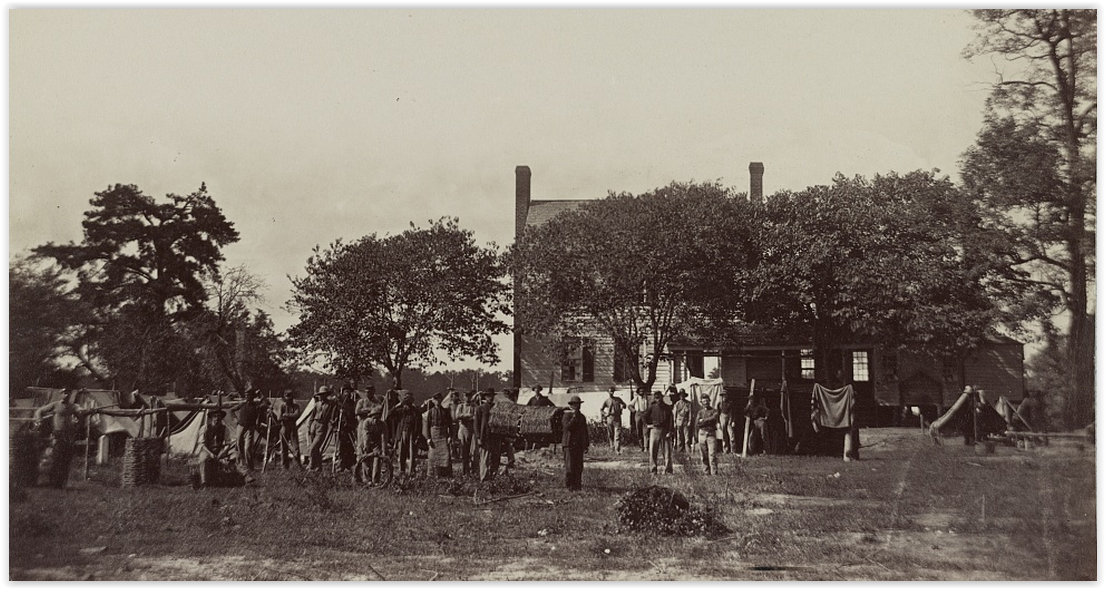
Cropped version of LC 32998. Headquarters U.S. Engineer Battalion in front of Petersburg, Va., September, 1864. Although this structure is not identified as the Williams house on the negative, Thompson's diary states the U.S. Engineers were quartered there in September 1864. The chimneys, roof style and trees match the McCallum drawing below.
Engineers at the Williams House
In September,1864, the U.S.Engineers worked on aspects of the front line west of the Jerusalem Plank Road and east of Fort Wadsworth on the Halifax Rd/Weldon Railroad and also on the Federal rear or secondary line in the same sector. Their camp was at the Williams house.
"September 5. Companies A and B returned to the main camp, following the line as far as Fort Davis. Company D, in marching order, left the main camp at 1 p.m. and went into camp at the Williams house, near the Jerusalem Plank Rd. During the night, the company went out on fatigue duty.
September 6. Company C left camp, in marching order, and joined Company D, in camp at the Williams house. Details from Company D laid out six batteries and a long line of rifle pits. This included the rear line selected September 1, and Batteries 26, 27, and 28. New: Evolution of the Federal line east of Fort Wadsworth
September 8-9. Companies A and B were engaged in putting the main camp in order. Companies C and D continued in camp at the Williams house, superintending the construction of fortifications in that vicinity."
Gilbert Thompson, “The Engineer Battalion in the Civil War: A Contribution to the History of the United States Engineers”. Number 44, Occasional Papers, Engineer School, U.S. Army. Press of the Engineer School 1910:84-85.
Gilbert Thompson
"September 5. Companies A and B returned to the main camp, following the line as far as Fort Davis. Company D, in marching order, left the main camp at 1 p.m. and went into camp at the Williams house, near the Jerusalem Plank Rd. During the night, the company went out on fatigue duty.
September 6. Company C left camp, in marching order, and joined Company D, in camp at the Williams house. Details from Company D laid out six batteries and a long line of rifle pits. This included the rear line selected September 1, and Batteries 26, 27, and 28. New: Evolution of the Federal line east of Fort Wadsworth
September 8-9. Companies A and B were engaged in putting the main camp in order. Companies C and D continued in camp at the Williams house, superintending the construction of fortifications in that vicinity."
Gilbert Thompson, “The Engineer Battalion in the Civil War: A Contribution to the History of the United States Engineers”. Number 44, Occasional Papers, Engineer School, U.S. Army. Press of the Engineer School 1910:84-85.
Gilbert Thompson
An engineer's notes on the map above, indicates the site for Fort Stevenson was chosen on September 1, 1864, it was profiled on September 11 by Company D, U.S. Engineers, and they worked on the fort until the16th. The undated Andrew McCallum drawing below must have been done on or shortly after September 11.
 Detail from Andrew McCallum sketch View of the Near [sic, should be "Rear"] Line on the Weldon Railroad Near the Williams House. Becker Collection, Boston College.
Key: 1 Preparations for building large fort to command the lines// 2 Williams House// 3 Batteries// View of the near [sic, should be "rear"] line on Weldon Railroad near Wiiliams House.
Detail from Andrew McCallum sketch View of the Near [sic, should be "Rear"] Line on the Weldon Railroad Near the Williams House. Becker Collection, Boston College.
Key: 1 Preparations for building large fort to command the lines// 2 Williams House// 3 Batteries// View of the near [sic, should be "rear"] line on Weldon Railroad near Wiiliams House.
There are many interesting details in this drawing. Although the house still stands, the outbuildings have been stripped of wood and are denoted by chimneys. In the left foreground, the frames for constructing Fort Stevenson are prominent. Note the gabions in the gun embrasures in the right foreground. The guard on the parapet stands in approximately the location of the red X on the map below.
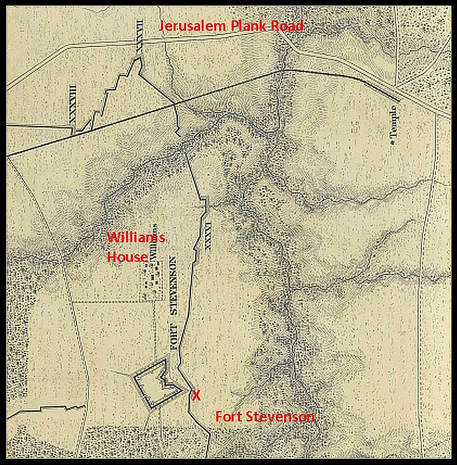
On June 21, 1864, Theodore Lyman, of Meade's staff, wrote about the Williams house, which was involved in what is known as the Battle of Jerusalem Plank Road: "Before us, to the left, was a big cornfield and a white wooden house, of good size, and with several outbuildings ….The house was deserted, but belonged to one Williams--“Massa dun gone ter Petersburg; but kirry mos all um furniture with him.”—but he left the ice which was the essential; also were there several milch cows and numerous astonished negroes" (p 218)....
On October 14, 1864, Theodore Lyman "Rode with the General [Meade] to Fort Stevenson, which is now not far from done, a work of large relief, capable of sheltering near 1,000 men, and with a bastion front. The Williams house has disappeared and the country is hardly to be recognized, so much timber has been felled and slashed” (p. 280)....
Meade’s Army: The Private Notebooks of Lt. Col. Theodore Lyman. Edited by David Lowe, The Kent State University Press: 2007.
On October 14, 1864, Theodore Lyman "Rode with the General [Meade] to Fort Stevenson, which is now not far from done, a work of large relief, capable of sheltering near 1,000 men, and with a bastion front. The Williams house has disappeared and the country is hardly to be recognized, so much timber has been felled and slashed” (p. 280)....
Meade’s Army: The Private Notebooks of Lt. Col. Theodore Lyman. Edited by David Lowe, The Kent State University Press: 2007.

